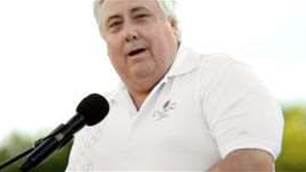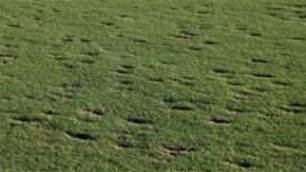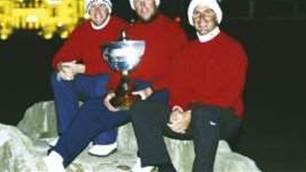TAKE a good look at the picture here. It was taken during the week of the 2009 Australian Masters at Kingston Heath.
TAKE a good look at the picture here. It was taken during the week of the 2009 Australian Masters at Kingston Heath. Look at the crowds … amazing. And to think this was during a practice round. Thousands of golf fans had flocked to the course in the off chance of getting a glimpse of then-world No.1 Tiger Woods.
As one of those in the crowd, I can testify that it was an incredible buzz to be among such a huge crowd, craning to simply get a split-second view of that swing.
So much has obviously changed since that day, and I’m not talking about the scandal and subsequent fall from grace, on and off the course, by Woods. I’m talking about the state of tournament golf in Australia.
Regular readers of this column will be aware of my concerns of the hangover that would beset the Australasian Tour after the incredible highs created last year by the Presidents Cup and the quality fields established for the Australian Open and PGA played either side of the event.
I am writing this column 36 days before the opening tee shot of the first event of the Australian summer. The $2 million Perth International (see our preview starting on page 38) is a new tournament and is also the richest on the Australasian Tour. It is also co-sanctioned with the European Tour and is owned and promoted by the International Management Group. It will be played at the highly regarded Lake Karrinyup course.
But such is the timing of the tournament in the third week of October that it must be like pulling teeth for IMG trying to secure top-line players for the event. IMG has been hanging their hat on inspiring the golfing public with the presence of South African Charl Schwartzel and in-form American Jason Dufner. With all due respect to the high quality golfing skills these two players possess, they are not headline acts. They will undoubtedly put in a good performance and contend for the title but will the crowds come?
Adding to this is the fact that IMG had not, at the time of writing, officially released the names of any other player contesting the event. It has, however, promised to deliver to the event another player ranked in the top-25 in the world. That’s fine, but leaving such announcements to only a few weeks before the first shot is not going to help attract people to travel to Perth from the eastern states to be part of the gallery.
Next month, the Australian Masters will return to Kingston Heath and Adam Scott will be one of the star attractions with defending champion Ian Poulter and Northern Ireland’s Graeme McDowell. Scott will be the major crowd puller again at the Australian Open from December 6 to 9, alongside Geoff Ogilvy, last year’s winner Greg Chalmers and eight-time major champion, 63-year-old Tom Watson. The PGA of Australia is yet to make any player announcements for its championship at Palmer Coolum Resort starting on December 13.
As I write this, no free-to-air TV broadcast deal for Perth, the Masters or Open had been announced. Channel Ten will deliver its last tournament broadcast at the PGA Championship having announced it is walking away from golf coverage.
Missing from all events this summer will be two of our top-ranked players – Jason Day, who says he needs to work on his game at home in the US and be with his young family, and Aaron Baddeley, whose wife Richelle is expecting their third child in early December. No one begrudges Day and Baddeley needing to be with their families.
But the inability of some of our players to commit to events back home is a problem that is going to escalate now that the US PGA Tour plans to run a 12-month season beginning in October each year. Australian players looking to keep their PGA Tour card will need to grow their earnings in events that will clash with Australasian tournaments. It is not the fault of the players that they won’t be able to come home.
Then there are the players, like Day and Baddeley, who have established a life, family and home in the US and after a long year on the PGA Tour are looking to have a break with their family over Thanksgiving and on into Christmas.
Both of these scenarios are a real problem for tournament organisers here who rely on our best 20 to 25 players to support the Australasian Tour and compete alongside one or two overseas drawcards getting an appearance fee. The way I see it, it’s not the commitment of the players, it’s the timing of our events that is now the major hurdle to their ongoing viability.
In my opinion, the Tour would do well to abandon scheduling events in November and December, a time which is now dominated by huge money, limited field events for the game’s very best. There was a time not so very long ago that tournaments like the Australian Masters and the now defunct Heineken Classic (which was our richest event a decade ago) were played in late January through to mid-February. If Australasian events were scheduled across four or five weeks at that time of the year, they would no longer clash with the vital opening five or six weeks of the PGA Tour season.
For mine, OneAsia has not succeeded in doing anything for the betterment of the game in Australia. There is little or no TV coverage of that Tour available here and outside of golf-devoted magazines and websites, it gets no media coverage. It is true that OneAsia has given Australian golfers another Tour to play on but the gaps between events does little to help the Tour’s momentum and promotion. The fact that two Tours are running side by side in the Asian region only confuses the public, while most Australian golf fans would not even be aware, after three years, that our Open and PGA championships are the last order of merit events on OneAsia.
This is why the PGA Tour of Australasia needs to reassess its involvement in OneAsia and look to a closer alliance with the European Tour, which is quite clearly the second biggest Tour in the world and can be seen on our TV screens every week. An Australian swing of the European Tour, particularly during the northern hemisphere winter, clearly has some merit for all – players, tournament organisers and the Tours.
Drastic changes are needed if our remaining Tour events are to survive and, hopefully, inspire a new generation of boys and girls to play this great game. Until then, take another look at the photo. I believe we won’t see these sorts of crowds this summer or for a few to come unless something is done. I am, however, more than happy to be proven wrong.
WHAT DO YOU THINK?
What needs to change to boost tournament golf in Australia? Who would you like to see play in Australia? Let me know your thoughts via email at golf@golfaustralia.com.au or simply leave your comment below. Follow me on Twitter @BrendanJames2
Related Articles

Palmer Has Titantic Opportunity

Tossing Bricks & Bouquets














